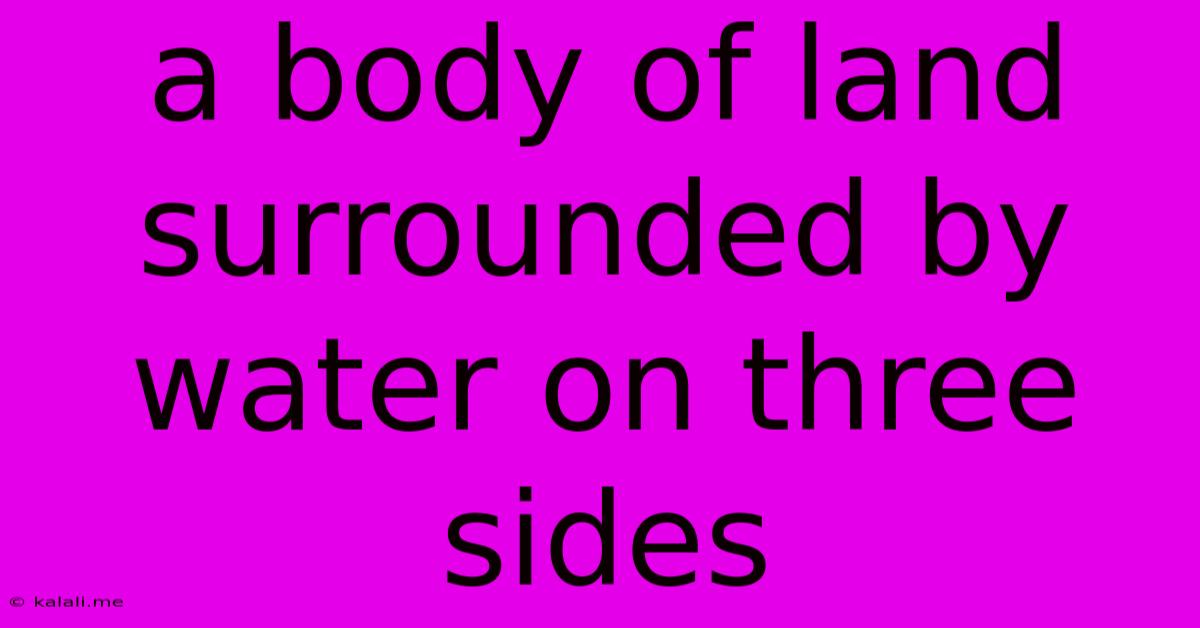A Body Of Land Surrounded By Water On Three Sides
Kalali
Jun 15, 2025 · 3 min read

Table of Contents
Understanding a Body of Land Surrounded by Water on Three Sides: Peninsulas, Capes, and More
A landmass surrounded by water on three sides is a geographical feature that encompasses several distinct terms, depending on its size, formation, and connection to the mainland. While the immediate image conjures up a peninsula, the reality is more nuanced. This article will explore the different types of landforms that fit this description, clarifying the distinctions and providing examples. Understanding these differences is crucial for both geographical accuracy and effective communication.
Defining a Peninsula
The most common term for a landmass surrounded by water on three sides is a peninsula. Peninsulas are relatively large landforms, significantly larger than other similar features. They are connected to a larger landmass, usually a continent or a large island, by an isthmus – a narrow strip of land. This connection is key to distinguishing a peninsula from an island. Think of a peninsula as a "finger" of land extending into the water. Famous examples include the Iberian Peninsula (Spain and Portugal), the Italian Peninsula, and the Korean Peninsula. The size and shape of peninsulas are highly variable, contributing to their diverse ecosystems and cultural landscapes. Factors such as climate, geology, and human activity all play significant roles in shaping their characteristics.
Differentiating Capes and Promontories
Smaller landforms that are also surrounded by water on three sides include capes and promontories. These are often rocky headlands projecting into the sea. The difference is often subtle, with "cape" being a more general term and "promontory" sometimes implying a more significant or dramatic projection. Both are considerably smaller than peninsulas. Cape Cod in Massachusetts, USA, and Cape Horn at the southern tip of South America are excellent examples of capes. Their strategic locations often lead to historical and economic significance. Coastal erosion and deposition continually shape the features of capes and promontories, leading to their distinctive forms.
Other Similar Landforms: Points and Headlands
The terms point and headland are also used to describe smaller landforms projecting into water. While these may also be surrounded by water on three sides, they are generally less dramatic in scale than capes and promontories. A point is a simple projection of land, often less prominent than a headland. A headland is a more rugged and significant extension of land, often featuring cliffs and rocky terrain. These landforms frequently exhibit unique biodiversity due to their exposure to diverse marine environments. They are often important for navigation and coastal defense.
The Importance of Context
Ultimately, the most appropriate term for a landmass surrounded by water on three sides depends heavily on context. Size, shape, and the surrounding geographical features are all crucial factors. While a peninsula is the most likely descriptor for larger landforms, smaller projections require a more nuanced approach, incorporating terms like cape, promontory, point, or headland. Accurate geographical terminology is essential for clear and precise communication in various fields, including geography, cartography, and environmental studies. The study of these landforms provides valuable insights into geological processes and their impact on coastal environments.
Latest Posts
Latest Posts
-
Sum Of The Protons And Neutrons
Jun 15, 2025
-
What Is The Largest Satellite In Our Solar System
Jun 15, 2025
-
What Is The Lcm Of 18 And 45
Jun 15, 2025
-
Which Of The Following Is Not A Goal Of Science
Jun 15, 2025
-
What Is The Prime Factorization Of 420
Jun 15, 2025
Related Post
Thank you for visiting our website which covers about A Body Of Land Surrounded By Water On Three Sides . We hope the information provided has been useful to you. Feel free to contact us if you have any questions or need further assistance. See you next time and don't miss to bookmark.